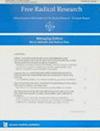氢过氧自由基(HOO•)作为还原剂:与抗氧化剂意想不到的协同作用。复习一下。
IF 3.6
3区 生物学
Q2 BIOCHEMISTRY & MOLECULAR BIOLOGY
引用次数: 4
摘要
本文综述了近年来在脂质过氧化过程中利用羟基自由基(HOO•)的特殊化学性质,特别是其与抗氧化剂的相互作用方面所取得的进展。HOO•自由基是超氧化物的质子化形式,在非水体系中脂质过氧化的增殖和终止中起着重要作用。然而,与仅具有氧化能力的烷基过氧基(ROO•)自由基不同,HOO•具有双面氧化和还原活性。HOO•自由基可以通过h原子转移(A•+ HOO•汉化AH + O2)降低抗氧化剂(酚类和芳香胺类)的自由基,从而延长抗氧化剂的抑制期,提高抗氧化剂的有效性。HOO•和ROO•自由基的同时存在触发了醌类和氮氧化物的催化抗氧化活性,并解释了黑色素样聚合物的抗氧化活性。HOO•自由基可由源自胺、醇、取代烯烃的ro•自由基裂解形成,并可在许多氧化体系中以低浓度存在。亲芳香族化合物,如天然精油成分γ-萜烯,是HOO•最有效的来源,并在氮氧化物或醌存在时作为共抗氧化剂。并对HOO•化学在抑制自氧化方面的应用前景进行了展望。本文章由计算机程序翻译,如有差异,请以英文原文为准。
Hydroperoxyl radical (HOO•) as a reducing agent: unexpected synergy with antioxidants. A review.
Abstract This review highlights the progress made in recent years in harnessing the peculiar chemistry of the hydroperoxyl, or perhydroxyl, radical (HOO•) during lipid peroxidation, particularly with regard to its interaction with antioxidants. The HOO• radical, the protonated form of superoxide, plays an important role in the propagation and termination of lipid peroxidation in nonaqueous systems. However, differently from alkylperoxyl (ROO•) radicals that have only oxidizing ability, HOO• has a two-faced oxidizing and reducing activity. The HOO• radical can reduce the radical of the antioxidant (phenols and aromatic amines) by H-atom transfer (A• + HOO• ⟶ AH + O2) thus increasing the length of the inhibition period and the effectiveness of the antioxidant. The simultaneous presence of HOO• and ROO• radicals triggers the catalytic antioxidant activity of quinones and nitroxides and explains the antioxidant activity of melanin-like polymers. The HOO• radical can be formed by fragmentation of ROO• radicals deriving from amines, alcohols, substituted alkenes and may be present at low concentrations in many oxidizing systems. Pro-aromatic compounds, like the natural essential oil component γ-terpinene, are the most effective sources of HOO• and behave as co-antioxidants in the presence of nitroxides or quinones. The future developments and applications of HOO• chemistry in the context of the inhibition of autoxidation are also discussed.
求助全文
通过发布文献求助,成功后即可免费获取论文全文。
去求助
来源期刊

Free Radical Research
生物-生化与分子生物学
CiteScore
6.70
自引率
0.00%
发文量
47
审稿时长
3 months
期刊介绍:
Free Radical Research publishes high-quality research papers, hypotheses and reviews in free radicals and other reactive species in biological, clinical, environmental and other systems; redox signalling; antioxidants, including diet-derived antioxidants and other relevant aspects of human nutrition; and oxidative damage, mechanisms and measurement.
 求助内容:
求助内容: 应助结果提醒方式:
应助结果提醒方式:


